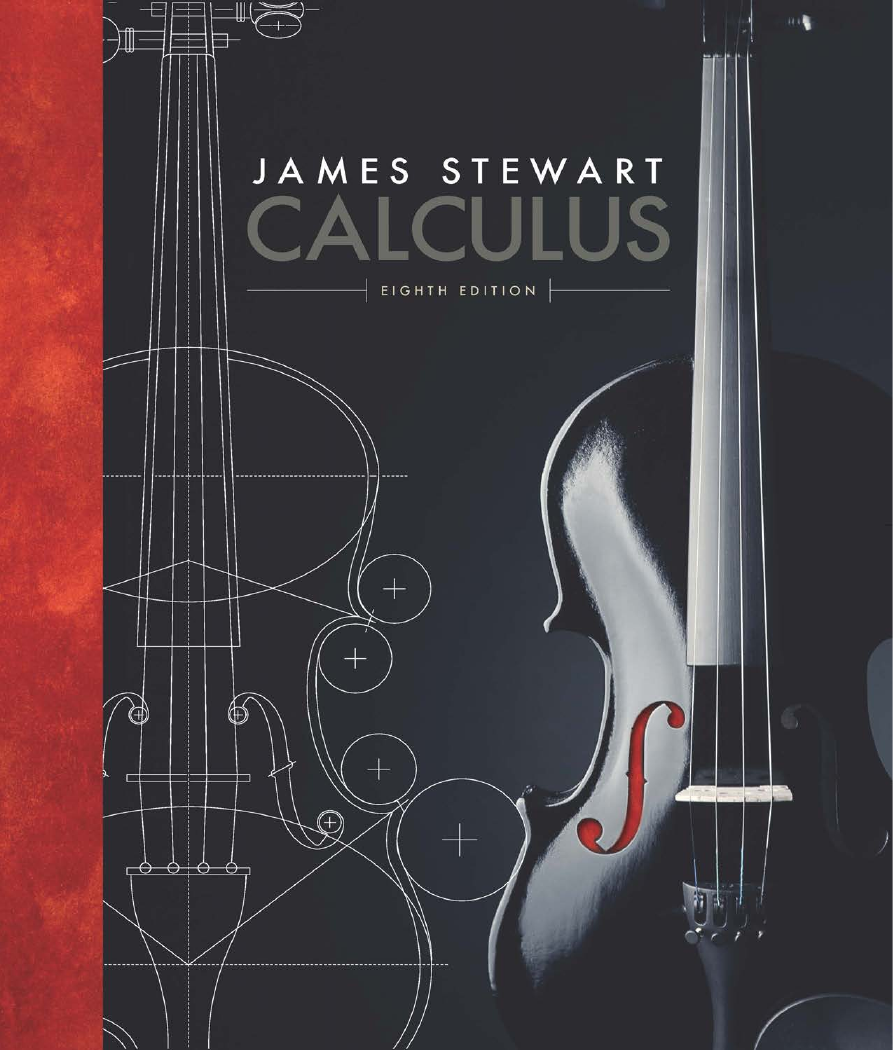Contents
Preface
To the Student
Calculators, Computers, and Other Graphing Devices
Diagnostic Tests
A Preview of Calculus
Ch 1: Functions and Limits
1.1: Four Ways to Represent a Function
1.2: Mathematical Models: A Catalog of Essential Functions
1.3: New Functions from Old Functions
1.4: The Tangent and Velocity Problems
1.5: The Limit of a Function
1.6: Calculating Limits Using the Limit Laws
1.7: The Precise Definition of a Limit
1.8: Continuity
Review
Principles of Problem Solving
Ch 2: Derivatives
2.1: Derivatives and Rates of Change
2.2: The Derivative as a Function
2.3: Differentiation Formulas
2.4: Derivatives of Trigonometric Functions
2.5: The Chain Rule
2.6: Implicit Differentiation
2.7: Rates of Change in the Natural and Social Sciences
2.8: Related Rates
2.9: Linear Approximations and Differentials
Review
Problems Plus
Ch 3: Applications of Differentiation
3.1: Maximum and Minimum Values
3.2: The Mean Value Theorem
3.3: How Derivatives Affect the Shape of a Graph
3.4: Limits at Infinity; Horizontal Asymptotes
3.5: Summary of Curve Sketching
3.6: Graphing with Calculus and Calculators
3.7: Optimization Problems
3.8: Newton's Method
3.9: Antiderivatives
Review
Problems Plus
Ch 4: Integrals
4.1: Areas and Distances
4.2: The Definite Integral
4.3: The Fundamental Theorem of Calculus
4.4: Indefinite Integrals and the Net Change Theorem
4.5: The Substitution Rule
Review
Problems Plus
Ch 5: Applications of Integration
5.1: Areas between Curves
5.2: Volumes
5.3: Volumes by Cylindrical Shells
5.4: Work
5.5: Average Value of a Function
Review
Problems Plus
Ch 6: Inverse Functions: Exponential, Logarithmic, and Inverse Trigonometric Functions
6.1: Inverse Functions
6.2: Exponential Functions and Their Derivatives
6.3: Logarithmic Functions
6.4: Derivatives of Logarithmic Functions
6.2*: The Natural Logarithmic Function
6.3*: The Natural Exponential Function
6.4*: General Logarithmic and Exponential Functions
6.5: Exponential Growth and Decay
6.6: Inverse Trigonometric Functions
6.7: Hyperbolic Functions
6.8: Indeterminate Forms and l'Hospital's Rule
Review
Problems Plus
Ch 7: Techniques of Integration
7.1: Integration by Parts
7.2: Trigonometric Integrals
7.3: Trigonometric Substitution
7.4: Integration of Rational Functions by Partial Fractions
7.5: Strategy for Integration
7.6: Integration Using Tables and Computer Algebra Systems
7.7: Approximate Integration
7.8: Improper Integrals
Review
Problems Plus
Ch 8: Further Applications of Integration
8.1: Arc Length
8.2: Area of a Surface of Revolution
8.3: Applications to Physics and Engineering
8.4: Applications to Economics and Biology
8.5: Probability
Review
Problems Plus
Ch 9: Differential Equations
9.1: Modeling with Differential Equations
9.2: Direction Fields and Euler's Method
9.3: Separable Equations
9.4: Models for Population Growth
9.5: Linear Equations
9.6: Predator-Prey Systems
Review
Problems Plus
Ch 10: Parametric Equations and Polar Coordinates
10.1: Curves Defined by Parametric Equations
10.2: Calculus with Parametric Curves
10.3: Polar Coordinates
10.4: Areas and Lengths in Polar Coordinates
10.5: Conic Sections
10.6: Conic Sections in Polar Coordinates
Review
Problems Plus
Ch 11: Infinite Sequences and Series
11.1: Sequences
11.2: Series
11.3: The Integral Test and Estimates of Sums
11.4: The Comparison Tests
11.5: Alternating Series
11.6: Absolute Convergence and the Ratio and Root Tests
11.7: Strategy for Testing Series
11.8: Power Series
11.9: Representations of Functions as Power Series
11.10: Taylor and Maclaurin Series
11.11: Applications of Taylor Polynomials
Review
Problems Plus
Ch 12: Vectors and the Geometry of Space
12.1: Three-Dimensional Coordinate Systems
12.2: Vectors
12.3: The Dot Product
12.4: The Cross Product
12.5: Equations of Lines and Planes
12.6: Cylinders and Quadric Surfaces
Review
Problems Plus
Ch 13: Vector Functions
13.1: Vector Functions and Space Curves
13.2: Derivatives and Integrals of Vector Functions
13.3: Arc Length and Curvature
13.4: Motion in Space: Velocity and Acceleration
Review
Problems Plus
Ch 14: Partial Derivatives
14.1: Functions of Several Variables
14.2: Limits and Continuity
14.3: Partial Derivatives
14.4: Tangent Planes and Linear Approximations
14.5: The Chain Rule
14.6: Directional Derivatives and the Gradient Vector
14.7: Maximum and Minimum Values
14.8: Lagrange Multipliers
Review
Problems Plus
Ch 15: Multiple Integrals
15.1: Double Integrals over Rectangles
15.2: Double Integrals over General Regions
15.3: Double Integrals in Polar Coordinates
15.4: Applications of Double Integrals
15.5: Surface Area
15.6: Triple Integrals
15.7: Triple Integrals in Cylindrical Coordinates
15.8: Triple Integrals in Spherical Coordinates
15.9: Change of Variables in Multiple Integrals
Review
Problems Plus
Ch 16: Vector Calculus
16.1: Vector Fields
16.2: Line Integrals
16.3: The Fundamental Theorem for Line Integrals
16.4: Green's Theorem
16.5: Curl and Divergence
16.6: Parametric Surfaces and Their Areas
16.7: Surface Integrals
16.8: Stokes' Theorem
16.9: The Divergence Theorem
16.10: Summary
Review
Problems Plus
Ch 17: Second-Order Differential Equations
17.1: Second-Order Linear Equations
17.2: Nonhomogeneous Linear Equations
17.3: Applications of Second-Order Differential Equations
17.4: Series Solutions
Review
Appendixes
Appendix A: Numbers, Inequalities, and Absolute Values
Appendix B: Coordinate Geometry and Lines
Appendix C: Graphs of Second-Degree Equations
Appendix D: Trigonometry
Appendix E: Sigma Notation
Appendix F: Proofs of Theorems
Appendix G: Complex Numbers
Appendix H: Answers to Odd-Numbered Exercises
Index
















 2023年江西萍乡中考道德与法治真题及答案.doc
2023年江西萍乡中考道德与法治真题及答案.doc 2012年重庆南川中考生物真题及答案.doc
2012年重庆南川中考生物真题及答案.doc 2013年江西师范大学地理学综合及文艺理论基础考研真题.doc
2013年江西师范大学地理学综合及文艺理论基础考研真题.doc 2020年四川甘孜小升初语文真题及答案I卷.doc
2020年四川甘孜小升初语文真题及答案I卷.doc 2020年注册岩土工程师专业基础考试真题及答案.doc
2020年注册岩土工程师专业基础考试真题及答案.doc 2023-2024学年福建省厦门市九年级上学期数学月考试题及答案.doc
2023-2024学年福建省厦门市九年级上学期数学月考试题及答案.doc 2021-2022学年辽宁省沈阳市大东区九年级上学期语文期末试题及答案.doc
2021-2022学年辽宁省沈阳市大东区九年级上学期语文期末试题及答案.doc 2022-2023学年北京东城区初三第一学期物理期末试卷及答案.doc
2022-2023学年北京东城区初三第一学期物理期末试卷及答案.doc 2018上半年江西教师资格初中地理学科知识与教学能力真题及答案.doc
2018上半年江西教师资格初中地理学科知识与教学能力真题及答案.doc 2012年河北国家公务员申论考试真题及答案-省级.doc
2012年河北国家公务员申论考试真题及答案-省级.doc 2020-2021学年江苏省扬州市江都区邵樊片九年级上学期数学第一次质量检测试题及答案.doc
2020-2021学年江苏省扬州市江都区邵樊片九年级上学期数学第一次质量检测试题及答案.doc 2022下半年黑龙江教师资格证中学综合素质真题及答案.doc
2022下半年黑龙江教师资格证中学综合素质真题及答案.doc